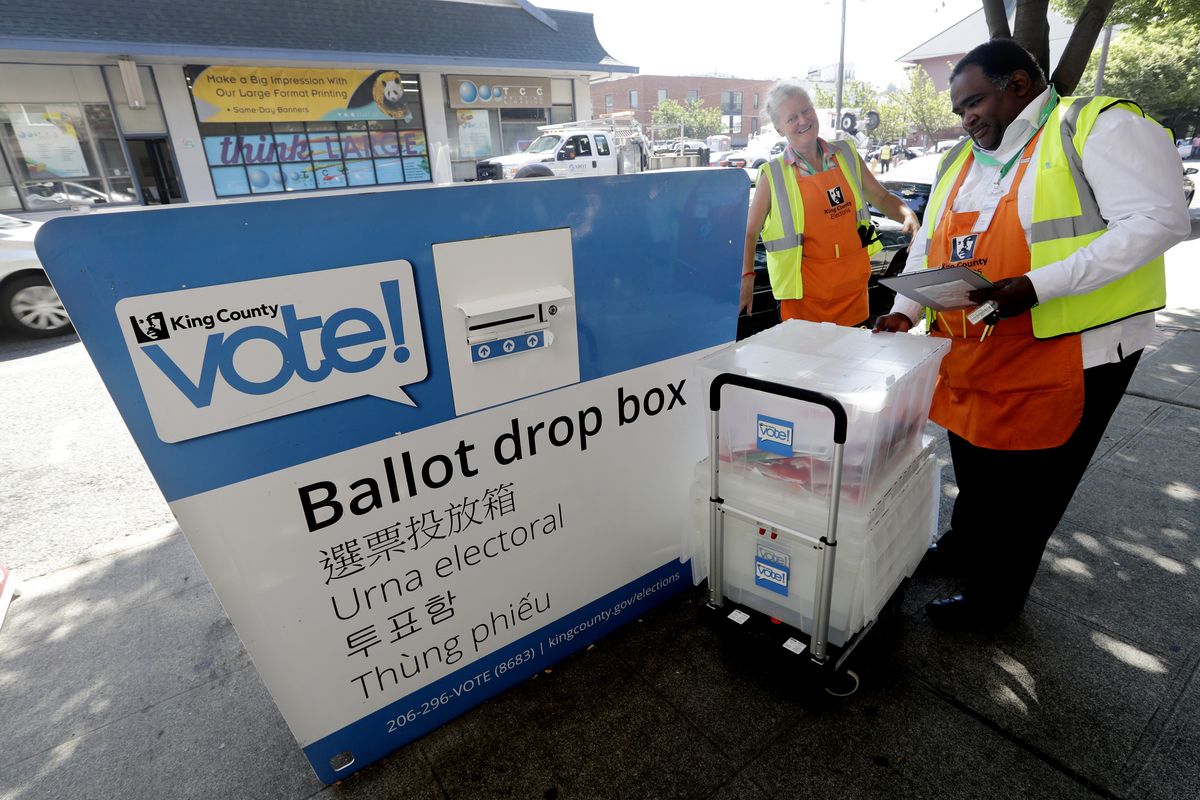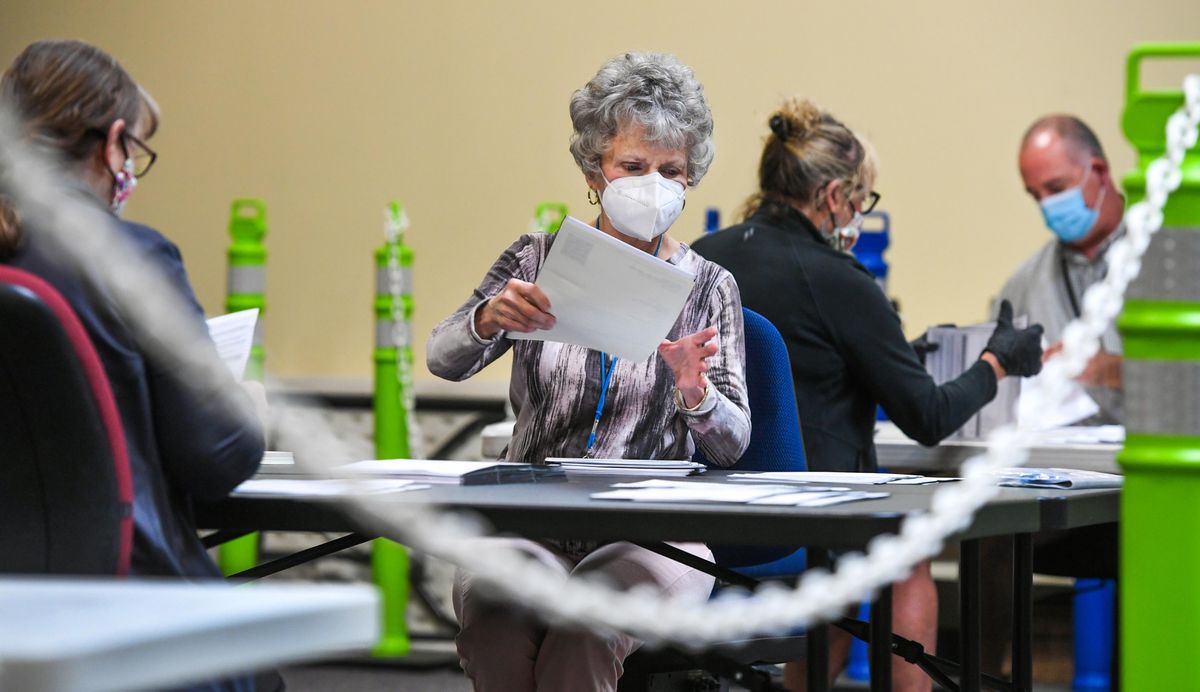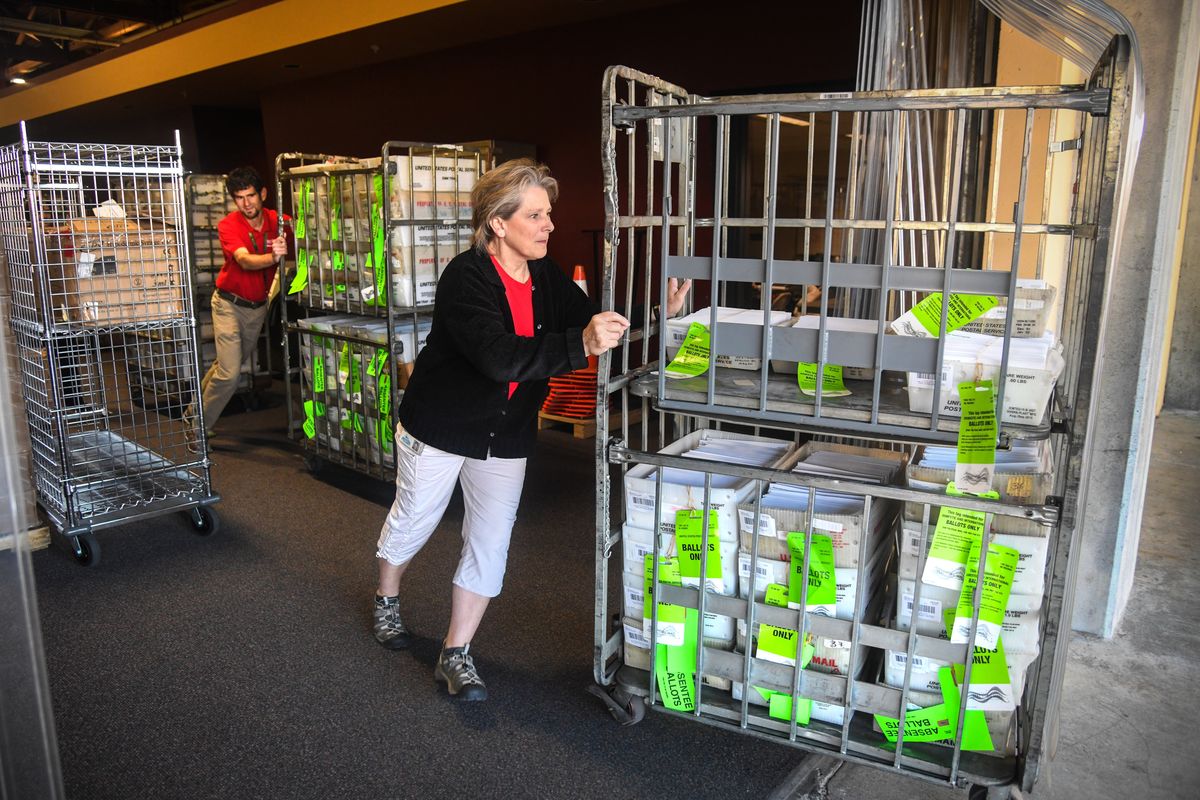Safeguards in place through Washington’s voting process to protect integrity of elections
Spokane County Elections’ extra help, Christa McQueen, center, counts a handful of ballots during a recount Aug. 24. Close tallies in the Spokane City Council District 1 race between Naghmana Sherazi and Luc Jasmin III, and a Rockford City Council race between Ivan Willmschen and Rachelle Arriaga, prompted the recount. (DAN PELLE/THE SPOKESMAN-REVIEW)Buy a print of this photo
During the last major election, the Office of the Secretary of State received phone calls and emails asking about election security. The public expressed a variety of concerns.
Our elections are safe and your vote is secure. According to a Brennan Center for Justice report, an American is more likely to “be struck by lightning” than be impersonated at the polls. America’s elections are among the safest and most secure worldwide.
Below are many of the protections in place in Washington to secure ballot and the integrity of the elections process.
• Election Officials diligently audit to prevent errors. The rare issues that arise can typically be traced to clerical or data-matching errors. Washington uses paper-based systems, and conducts voter-verifiable paper audit trails, independent testing, and pre- and postelection audits. The VoteWA.gov system is secured by skilled IT and the Washington State Elections Security Operations Center staff using state-of-the-art equipment and following IT industry best practices. The Office of the Secretary of State works with the Department of Homeland Security to ensure election systems remain secure.
• The right to vote is reserved only for U.S. citizens and is guaranteed by the U.S. Constitution. By law noncitizens are prohibited from registering to vote. If an undocumented immigrant or a documented resident alien attempts to register or vote, they risk being permanently deported. The risks are just too high compared to the rewards, if any, of casting just one vote in an election. That’s why noncitizens rarely intentionally attempt to vote. There are a handful of cases nationally of inadvertent registration by noncitizens, but those instances are found in routine checks.
• Vote counts – both paper and electronic versions – are safeguarded for accuracy, and elections are well-protected. Physical safety measures prevent unauthorized access to the machines that count, or tabulate, the votes. Backup audit trails or alarms warn of attempts to access any type of election machine, and these machines are never connected to the internet. Washington state uses paper ballots, which serve as the official record of the election, and the paper ballots can be recounted to confirm results. Vote counts are safe and accurate.
These additional topics are listed in order of the steps that occur during an active election cycle.
• Every American citizen in Washington state of voting age can register to vote. Each voter registration is checked to be sure that person is who they say they are, even if they share the same name with another person. A birthdate and either a Washington state ID or a Social Security number are required to register. One person, one registration, one vote.
• Washington’s Future Voter program permits 16- and 17-year-olds to sign up to be automatically registered to vote when they turn 18.
• Election offices maintain updated voter rolls. Either the Washington Department of Health or the Social Security Administration notifies county elections offices in Washington of all deaths reported within the state. On occasion, a ballot may end up being mailed to someone who died out of state or whose death has not yet been reported. It is the responsibility of the current resident to inform the elections office to prevent future ballots from being sent. Election rolls are well maintained and updated promptly.
• Every registered voter in Washington state is sent a ballot by mail. Election officials say they work diligently to ensure every registered voter is sent a ballot. But occasionally, delivery mishaps may occur. Any registered voter who does not receive their ballot should contact their county elections office to determine the best way to receive a replacement ballot.
• If a citizen is registered to vote, that citizen will receive a ballot. The county elections office won’t send or give a ballot to anyone who isn’t registered.
• Ballots come with prepaid-postage envelopes addressed to the county elections office so voters can send their ballots through the U.S. Postal Service. However, timing may affect post office delivery. As long as a ballot is postmarked before or on Election Day, that ballot will be counted. Voters have the option of placing their ballots in an official drop box, which is open until 8 p.m. the day of the election. Drop box locations are available at VoteWA.gov. Both systems deliver ballots directly to the election office.
• Replacement ballots are available. Though rare, sometimes a voter doesn’t receive their ballot in the mail, or a ballot may get damaged during handling. Voters may simply call their county elections office, which will mail a replacement ballot. Or the voter can download and print a ballot and signature declaration from the elections office website or VoteWA.gov. Both replacement ballot options require the ballot to be returned to the respective county elections office to be counted. Replacement ballots are safe and secure. Again, only one ballot can be counted for each voter.
• In Washington state, the voting process starts as soon as voters receive their ballots. If a voter marks, signs, and returns their ballot and then dies, their ballot is still valid. Multiple signature checks prevent forgery. Once a person’s ballot has been accepted for counting, their vote will count – whether the person is alive or deceased at the time of counting.
• Using an official ballot drop box is secure. Designated officials, working in pairs, open drop boxes and remove and deliver the ballots to their respective county elections office regularly. Ballot drop boxes are strong to prevent tampering and are highly secure. Ballots deposited in drop boxes are safe.
• All ballots are tracked and verified. The ballot-counting process begins with signature verification. Once they are validated, outer envelopes are opened to remove any connection to the voter’s identity. Next, the anonymous security envelopes or sleeves are opened and ballots are flattened. Finally, votes are counted and ballots are preserved. At every point, the exact same number of ballots that move from the previous station must be accounted for at the next. From the moment they arrive, ballots are tracked and kept safe.
• Only the first valid ballot accepted is counted. Voters may, whether in error or willfully, send in multiple ballots, but only the first valid, verified ballot is counted. A central database tracks and records the receipt of each verified ballot. Multiple ballots are flagged and not counted. Only the first valid ballot received is verified and counted.
• Only one ballot per voter per election is counted. As each signature is validated, a database is checked to verify that a ballot has not been counted for that voter. If a person submits more than one ballot in the same election, the ballot envelopes are set aside and reviewed. In some cases, voters are contacted to determine if an additional ballot was intentional or not. Only the first valid ballot submitted is counted.
• All ballot envelopes returned must pass multiple-point scrutiny. A ballot that arrives in an unsigned envelope cannot be counted. A voter’s signature is essential to the validation process. When counting ballots, the number of verified voters must match the number of validated ballots exactly.
• Signatures must pass multiple checks. Signatures are examined using Washington State Patrol procedures. If a ballot turns up without a signature, the voter is contacted and given until the last day before the end of the canvass period (the period from Election Day until the results are certified) to provide a signature that matches their official ballot signature. Election offices vigilantly match signatures before validating a ballot.
• A provisional ballot is counted only if it is verified. A provisional ballot is issued if a voter’s name is not listed as a registered voter, if they cannot sign their name, or if they do not have proper identification. The verification process checks registration, ensures the ballot is not a duplicate, and inspects the signature. Washington state offers in-person, same-day registration, which greatly reduces the need for provisional ballots. Only verified provisional ballots are counted.
• All valid ballots are counted in every election. Ballots without signatures, ballots with mismatched signatures, or ballots identified as duplicates are declared invalid. Election results are certified only after all valid ballots are counted.
• Only valid ballots are counted. If someone fills out and submits another person’s ballot, the signature will not match and the ballot will not be verified. All ballots must be verified before they are counted. Only ballots with valid signatures are counted.
• Every ballot returned to the elections office is saved. The elections office keeps a complete record of the election, including ballots that were invalidated and not counted. For federal elections, ballots and other materials are retained for 22 months.
• Ballots are tracked at every point in the election process. Ballots are tracked from the moment they arrive at the county elections office until they are archived after counting. At each point, ballots are checked to ensure that the number of validated voters matches the number of ballots moving through the process. Totals must match exactly.
• The actual physical paper ballots are the important documents. Electronic scanners assist in counting ballots, but actual humans check, recheck, and confirm that ballots are properly accounted for at every step of the process. Ballots can be hand counted in the case of extremely close elections. All ballots are preserved for possible recounts and examination.
• Vote-counting machines record the votes as they are entered. Scanners read the votes off a ballot and enter those numbers in the database. If a program is installed incorrectly, votes could appear for the wrong candidate. To protect our right to vote and ensure votes are counted accurately, premade test decks of ballots are used to check for problems. In a test deck, all results are known beforehand, and if the tabulator results do not match, the machine is reprogrammed and then retested until they do. Vote-tabulating machines record all votes as they appear on each cast ballot.
• Vote-counting records are kept safe. Multiple safety precautions, including built-in audit logs, prevent anyone from changing votes or from hacking the machines that tabulate the votes. Attempted changes are detected and the perpetrators are prosecuted.
• Official election observers are invited to be present at all times during the counting process. Ballots are unsealed, handled, and counted in the presence of observers. These include representatives of both major political parties, who are invited to watch in equal numbers, as well as nonpartisan representatives. Observers leave the building where the ballots are counted at the same time as the election staff. Ballots are processed only in the presence of staff and, if present, official observers.
• Not all ballots can be counted on election night. Election results are not final until all ballots are counted and the results are certified. Ballots received after Election Day may still be counted if they are postmarked on or before Election Day. Election officials will continue to process mailed ballots with acceptable postmarks until certification. Especially in close races, it may appear as if the winners are “flipping” during the counting process. But preliminary results, especially when the outcome is close, do sometimes change because they are just that – preliminary.
• Invalidated ballots can’t be added to the count. Photocopied ballots or forged ballots without a voter identification are not valid. They are not counted.
• All valid ballots are counted in every election. Photocopied ballots without a voter ID can’t be validated. They won’t be counted. The number of valid voters who voted and the number of ballots counted must match.
• Party affiliation is private in Washington state. Washington voters don’t register by political party. Voters are asked to declare their political party affiliation only during presidential primaries (part of the nomination process for U.S. president). That information is recorded on the voter’s registration record for 60 days, per state law, before being permanently removed from the voter’s record. If a candidate or political party has personal information, they got it from somewhere other than the government.
• Our votes are private. Other than ensuring that a ballot returned by mail is properly delivered to its respective county elections office, the U.S. Postal Service has no way to track ballots or their contents. Voter privacy is secure.
• How a person votes is strictly private. No one can obtain information from the elections office about how you voted on candidates and measures. Political parties gather what information they can from many sources, hoping to figure out whether a voter is conservative or liberal, to target their mailings accordingly. But ballot privacy is secure and protected.
• American elections are secure. Multiple layers of safeguards prevent outside interference from other countries. That we have a decentralized system, where elections occur at the local level, reinforces this. Across the country, in each state and in each county, election officials work diligently to keep elections safe from outside interference.



